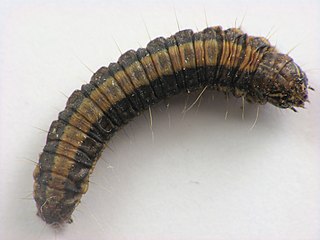
Spilomelinae is a very species-rich subfamily of the lepidopteran family Crambidae, the crambid snout moths. With 4,135 described species in 344 genera worldwide, it is the most speciose group among pyraloids.

Hypena is a genus of moths in the family Erebidae. It was first described by Franz von Paula Schrank in 1802. These non-migratory moths overwinter as pupae and almost never estivate as adults.

Elophila is a genus of moths of the family Crambidae described by Jacob Hübner in 1822.

Metasia is a genus of moths of the family Crambidae. They are found mainly in Europe and Australia, but also in Africa, Asia, North America, and Pacific islands.

Nacoleia is a genus of moths of the family Crambidae described by Francis Walker in 1859.

Udea is a genus of snout moths in the subfamily Spilomelinae of the family Crambidae. The genus was erected by Achille Guenée in 1845. The currently known 216 species are present on all continents except Antarctica. About 41 species are native to Hawaii.

Neurophyseta is a genus of moths of the family Crambidae.

Nymphicula is a genus of moths of the family Crambidae.

Lygropia is a genus of snout moths in the subfamily Spilomelinae of the family Crambidae. It currently comprises 66 species, which are mostly found in the tropical and subtropical regions of the Americas, Africa and Asia, but not in Australia.

Palpita is a genus of moths of the family Crambidae. Members of the moth genus Stemorrhages may be very similar in appearance.

Parapoynx is a genus of moths of the family Crambidae described by Jacob Hübner in 1825.

Petrophila is a genus of moths of the family Crambidae. The genus was described by Lansdown Guilding in 1830.

Phostria is a genus of moths of the family Crambidae.

Cerynea is a genus of moths of the family Erebidae erected by Francis Walker in 1859.
Chusaris is a genus of moths of the family Erebidae. It was erected by Francis Walker in 1859.

Corgatha is a genus of moths of the family Erebidae erected by Francis Walker in 1859.

Gesonia is a genus of moths of the family Erebidae erected by Francis Walker in 1859.
Glympis is a genus of moths of the family Erebidae. The genus was erected by Francis Walker in 1859.

The Epipaschiinae are a subfamily of snout moths. More than 720 species are known today, which are found mainly in the tropics and subtropics. Some occur in temperate regions, but the subfamily is apparently completely absent from Europe, at least as native species. A few Epipaschiinae are crop pests that may occasionally become economically significant.

Macalla is a genus of snout moths. It was described by Francis Walker in 1859.
















